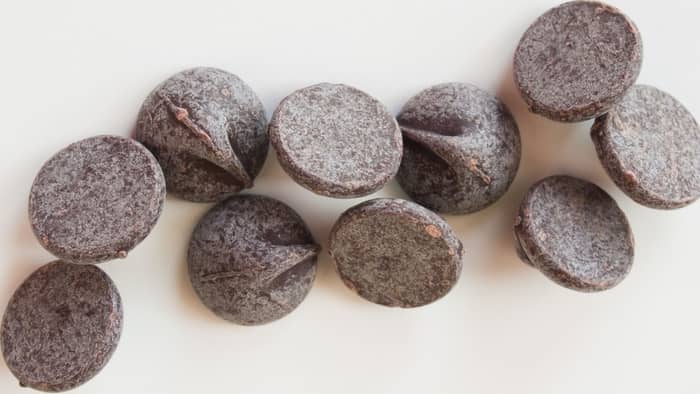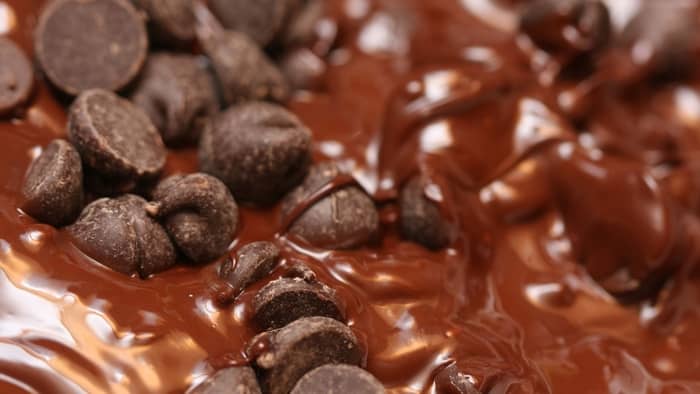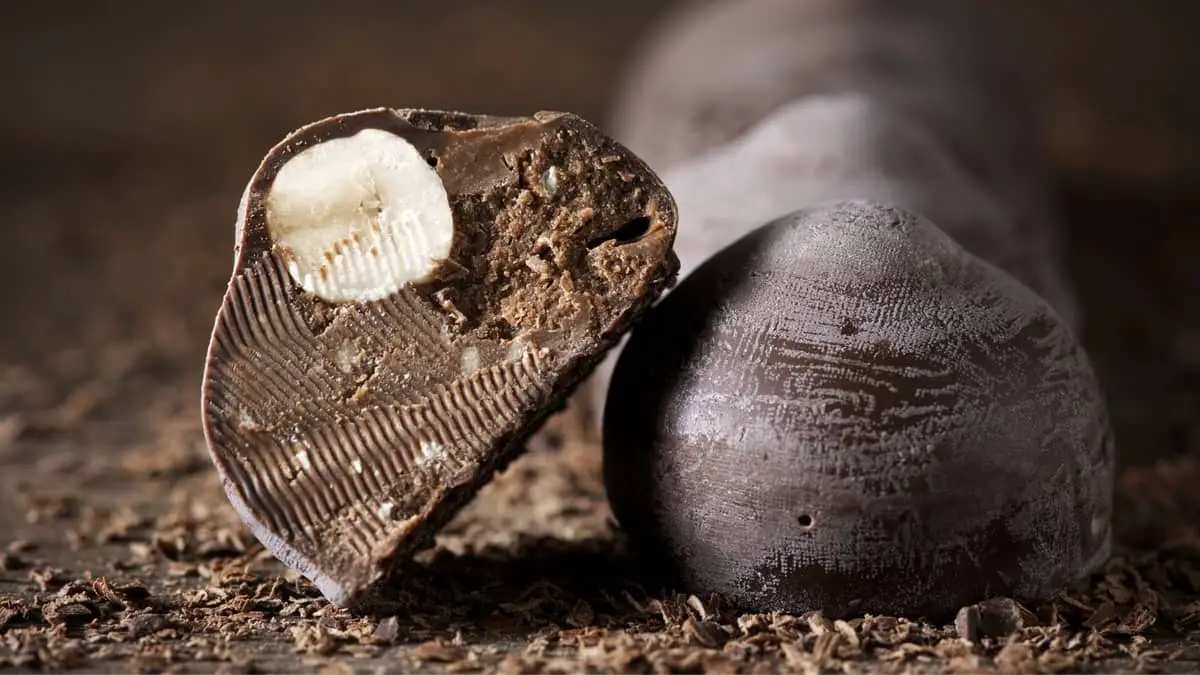Last Updated on February 17, 2022
It may appear as a great surprise that you notice white spots after unwrapping your chocolate. So, why does chocolate turn white? But, before anything else, you must know that this unique and dusty film on your chocolate is still safe for consumption.
Why Does Chocolate Turn White?
First things first, this particular white film on your chocolate does not mean it has spoiled. Likewise, this does not refer to molds. In most cases, it results from a scientific process known as chocolate bloom. For this reason, it would be best to know that there are two kinds of chocolate bloom: fat bloom and sugar bloom.
Most of the time, fat bloom happens because of inappropriate storage conditions. In addition to that, it is due to a poor tempering process or sudden temperature changes. Consequently, this bloom will give your chocolate a white-gray and powdery look. Not only that, but also it will make the chocolate bar incredibly soft.
On the other hand, sugar bloom typically occurs when moisture comes in contact with your chocolate. As a result, it will dissolve the sugar crystals on your chocolate’s surface. Because of this, it explains why there is a formation of a powdery and white look.

Chocolate bloom
If you are asking, why does old chocolate turn white? Well, for the most part, it may appear a bit less delicious compared to the rich and lustrous chocolatey-brown piece of candy that you recently purchased from the store. However, you should know that it is still safe to consume.
Additionally, you may discover the sugar-bloomed chocolate’s texture is grainy on the outside. However, it must still taste delectable; please note that the primary causes of why old chocolate turns white are overly-warm storage and drastic temperature changes.
That is why to avoid this from ever occurring to your old chocolate; it is necessary to practice appropriate storage techniques.
Moreover, why does chocolate turn white after melting? In most cases, it is due to dramatic changes in temperature. As a solution, it is best to melt your chocolate first. After that, make sure to work with your chocolate at a temperature lower than 89 degrees Fahrenheit. In addition to that, be sure to go lower in temperature if you are dealing with milk or white chocolate.
Furthermore, why does milk chocolate turn white? It is best to consider that the usual cause of milk chocolate that develops a white appearance is improper tempering. Not only that, you must bear in mind that if this ever occurs, this does not mean that it has spoiled. Although, they may not appear as lustrous and shiny as most chocolatiers would like.
Also, why does chocolate turn white in the refrigerator? You should be aware that the white marks appear whenever the chocolate’s fat particles separate because of hot or cold temperatures. In addition to that, the fat tends to rise to the chocolate’s surface through tiny cracks.
In that regard, be careful whenever refrigerating your chocolate since if you store it in an incredibly cold place, the fat bloom is most likely to occur.
OXO Good Grips POP Container – Airtight Food Storage
Best Way To Prevent Chocolate Bloom
All you have to remember whenever preventing your chocolate from ever blooming is to put it in a sealed container. With this, you have to ensure that you store it in a location that remains at approximately 70 degrees Fahrenheit.
Furthermore, you have to keep in mind that the fridge is exceedingly humid for your chocolate. That is why it would help to put it in the coolest part of the kitchen, for example, on a low shelf or a dim pantry.
Additionally, never allow your candy to sit through different temperature changes. In addition to that, an uncomfortable climate, for instance. The main reason is that it will not appear as good as new anymore.
Tempering chocolate correctly
For instance, you want to create a fruit juice-soaked cherry chocolate bar. In addition to that, you want to prevent sugar and fat blooming. Then, tempering your chocolate is the best way to go.
In this regard, start by tempering your chocolate. Then, make sure to fill the bar mold. Afterward, be sure to turn the mold upside down. After that, ensure to pour out the chocolate; doing this will allow you to have a thin chocolate coat in the mold.
Next, make sure to cool your mold till the chocolate sets up. After that, please add the juice-soaked cherries to the bar mold once cooled. Afterward, pour the tempered chocolate covering the cherries. But, be sure not to fill the mold to the maximum. Remember, it is always best to leave a little room; this will add a chocolate cap.
Also, remember that you are free to add a chocolate cap to the mold using tempered chocolate; keep in mind that the chocolate cap is a covering. Because of this, the chocolate touching the soaked fruit where the sugar blooms will be under the tempered chocolate’s cap. And as a result, it will not be visible.
Afterward, make sure to tap your mold gently. Doing so will remove all the bubbles. After this, ensure to chill. Then, be sure to turn the mold upside down once you have cooled and set your chocolate. Finally, you may pop out the finished molded chocolate.

Tips And Tricks
It is best to utilize a chocolate truffle mold most of the time. Likewise, you may use two coatings of chocolate that you enrobe around the fruit as a single piece; bear in mind that it would be best to do this whenever working with fluid-soaked fruits that are typically wet. Not only this but also this is for ease of use. Also, in most cases, bar molds are not suitable for this kind of chocolate production since they are thin.
Conclusion
Ultimately, despite all the efforts of most chocolatiers to avoid chocolate bloom, several can never completely control the shipping conditions; keep in mind that it refers to once the chocolates are on their way to their customers.
Moreover, it would be best to consider that the box may stay overnight in the carrier’s warehouse. In that regard, this is where the temperatures rise and fall drastically. As a result, it will cause a bloom to develop on your chocolate.
Additionally, please note that chocolate bloom, whether fat or sugar bloom, is indeed not harmful to your health. Because of this, you may proceed with consuming or using your chocolate to make your loved ones a well-deserved sweet.
Read more about How To Fix Chocolate Bloom – 3 Best and Most Effective Methods
FAQs
Besides, if your chocolate does not taste like before, it is still excellent for baking or making hot cocoa.
Why Does Chocolate Turn White After Melting?
It is because of drastic temperature changes. That is why if this ever happens to you, it would be best to melt the chocolate properly. With this, ensure to melt the chocolate at a temperature lower than 89 degrees Fahrenheit.
Why Does Old Chocolate Turn White?
Most of the time, the usual causes of chocolate turning white are dramatic temperature changes and overly-warm storage. So with this, do not be surprised if it looks less tasty compared to the lustrous and rich chocolate you typically see when you buy fresh chocolate. Nevertheless, it is not harmful, so you can still eat it.
Why Does Milk Chocolate Turn White?
Take note that improper tempering is the leading cause of why this occurs to your milk chocolate. But you do not have to worry too much since it is undoubtedly safe for consumption. The big difference you may observe is that it does not look as good as before.
Why Does Chocolate Turn White In The Refrigerator?
In most cases, it is because of cold temperatures. Remember, the fat usually rises to the chocolate's surface through your chocolate's tiny cracks. For this reason, it would help you a lot if you avoid storing your chocolate in the fridge. The main reason is that the fat bloom will usually happen to your chocolate.

Zarah is an experienced pastry chef whose creations have delighted countless customers. With a passion for baking, Zarah has developed a unique style that combines classic techniques with modern flavors. Her desserts are consistently crafted with the finest ingredients, and her attention to detail is evident in the stunning and delectable results. Zarah has a wealth of experience in the pastry kitchen, and loves to share her knowledge with others. Whether it is teaching a class or creating a custom cake for a special occasion, Zarah is committed to making sure every customer is satisfied.


